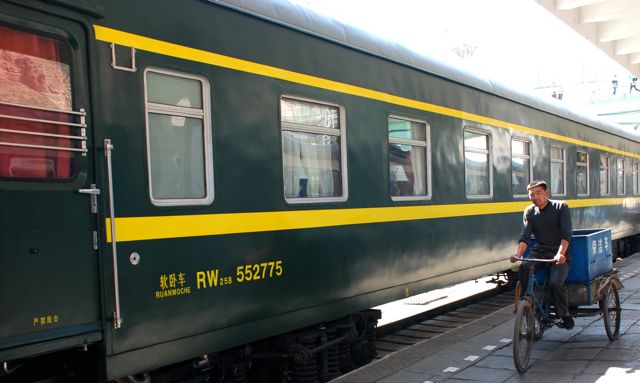Last Frontier: The Silk Road
(Editor’s note: Author Chris Card Fuller’s story about her 2007 Silk Road trip originally appeared in The International Railway Traveler® magazine, republished here with permission. Please note that although the itinerary is essentially unchanged, the tour operator no longer offers Heritage Class accommodations on the Golden Eagle Trans-Siberian Express.)

A gust of wind chases autumn leaves around the pavement. The flash of yellow and gold leaves and purple heather in the intense sunlight comes as a surprise, considering that we’re wedged in between three deserts. I’m just about to catch the perfect video clip of the Golden Eagle Trans-Siberian Express gliding into Dostyk, Kazakhstan.
We’re standing on the platform of Kazakhstan’s border town with China’s Xinjiang province. In 21 days, we will have covered almost 7,000 miles, from Beijing to Moscow, traversing some of the most inhospitable, lowest, hottest terrain on the planet. Until we actually catch some of the sand between our toes and view a dune from our perch on a camel’s back, the magnitude of our journey doesn’t begin to sink in.

This is the famed Silk Route. We’re separated from the world by unforgiving deserts and mountain ranges–the Tian Shan, the Pamirs Karakorum and the Kopa Degh. And to get to places like Mary, Turkmenistan, by way of Samarkand and Bukara in Uzbekistan and Almaty in Kazakhstan, you must have the proper visas. Camels can walk across these borders easier than tourists. Traveling by private train is one of the few ways you can get there.
We greet 90 west-to-east passengers emerging from their shiny blue compartments of the Golden Eagle Trans-Siberian Express, assisted by smartly uniformed Russian railway car attendants. They’ve just finished the first half of their trek which began in Moscow with stops in Volgograd, Khiva, Samarkand, Bukara, Almaty and Tashkent, before switching trains with us to finish the second half of their voyage on ‘our’ train the Shangri-la Express. Ahead of them lies the Tarim Basin, the Gobi Desert, and the Mogao’s Buddhist caves, carved between 1,500 and 1,600 years ago. In Xian, 6,000 terracotta warriors await their arrival. They’ll finish up where we began – at the Peninsula Hotel in Beijing, China’s 21st century capital and home to the 2008 Summer Olympics.

East-bound passengers will be learning to use chopsticks just about the time that we’re getting comfy in a Kazakh yurt. In the flurry of video and picture-taking with Kazakstan’s neatly turned-out border guards, we gather up our plunder – silks from Xian and pashminas from Turpan – before boarding the Golden Eagle Express. The blue and gold compartments are a welcome sight: all three categories are comfortable: Heritage class with twin beds, Silver Class with a double bed, and additional overhead bunk, a private shower and toilet facilities, closet, and TV/Video/CD player. Gold Class offers a little more closet space and shower space than Silver Class plus easy access to the bar car and the Gold Dining Car. Generous serving of vodka, unlimited wine with meals served in crystal stemware, caviar and sturgeon for our welcome and farewell dinners, 24 hour coffee and tea service in our compartments – such luxurious details – can be distracting. We’re traversing the harshest of deserts and mountain passes in the protective cocoon of our air-conditioned private train.

If you think train travel over several thousand miles of desert might be boring, it isn’t…
Oasis towns like Turpan in Xinjiang, China are lush and brimming with vineyards. Poplar trees line the newly constructed asphalt Silk Road highway. In Samarkand, nothing is quite as exotic as the haute-couture-clad Uzbeki models tearing up the catwalk during our private fashion show in a merchant’s former private palace.
Almaty, Kazakhstan’s modern capital city, is the antithesis of rustic. It may be where the apple originated, but you’ll find more stretch limos here than apple orchards. We’re entertained in a carpeted yurt restaurant, but the performers sing arias just as proficiently as traditional folksongs.

Food in Central Asia is also a pleasant surprise. For local lunches and dinners, we’re served hearty soups, spiced meats and plentiful vegetables with rice pilaf and fresh pita bread. Most meals begin with a plate of pickled raw vegetables such as cucumbers and beets, local cheeses and olives. Sweet melons and dried fruits are specialties of these oases towns.
“We are the lowest, the hottest, and the sweetest place on earth,” is how Zeba, a Turpan resident guide, describes her oasis home in the Taklimakan desert. The desert offers up a few, but not all, of its secrets.
At the Urumchi Provincial museum in China’s Xinjiang province, we meet the ‘Loulan Beauty’. This blond-haired Indo-European petrified corpse was officially dated at 3,700-years-old, yet some archeologists believe she may be even older.

The 2,300-year-old ruins of Jiaohe city near Turpan used to be a Han-era garrison town built to fend off northern marauders. This complex of carefully laid-out city streets has been described as “the largest, oldest and best-preserved earthen city in the world.”
I’m no history expert. My Tang and Han dynasty dates usually get twisted up in a knot, but of one thing, I’m dead certain: As soon as this trip ends, I’ll want to hop right back on the train and see it all again.
(When not traveling, Chris Card Fuller divides her time between Paris, France and Florida.)
For more information on the Silk Road tour, please click here.


